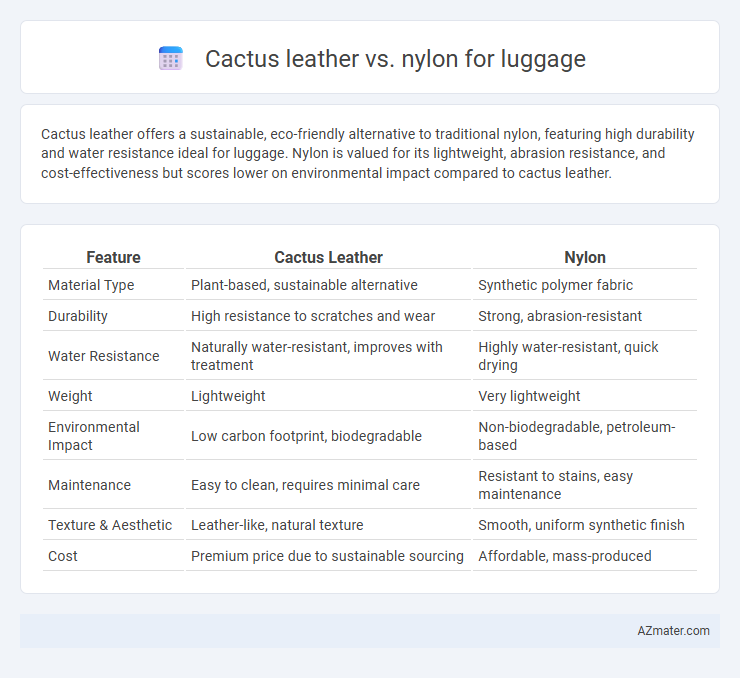Cactus leather offers a sustainable, eco-friendly alternative to traditional nylon, featuring high durability and water resistance ideal for luggage. Nylon is valued for its lightweight, abrasion resistance, and cost-effectiveness but scores lower on environmental impact compared to cactus leather.
Table of Comparison
| Feature | Cactus Leather | Nylon |
|---|---|---|
| Material Type | Plant-based, sustainable alternative | Synthetic polymer fabric |
| Durability | High resistance to scratches and wear | Strong, abrasion-resistant |
| Water Resistance | Naturally water-resistant, improves with treatment | Highly water-resistant, quick drying |
| Weight | Lightweight | Very lightweight |
| Environmental Impact | Low carbon footprint, biodegradable | Non-biodegradable, petroleum-based |
| Maintenance | Easy to clean, requires minimal care | Resistant to stains, easy maintenance |
| Texture & Aesthetic | Leather-like, natural texture | Smooth, uniform synthetic finish |
| Cost | Premium price due to sustainable sourcing | Affordable, mass-produced |
Introduction: Cactus Leather and Nylon in Modern Luggage
Cactus leather, derived from sustainable prickly pear plants, offers an eco-friendly alternative to traditional materials used in modern luggage. Known for its durability, water resistance, and unique texture, cactus leather appeals to environmentally conscious consumers seeking stylish and resilient travel gear. Nylon remains a popular choice for luggage due to its lightweight nature, high tensile strength, and resistance to abrasion, making it a practical option for frequent travelers.
Material Origins: How Cactus Leather and Nylon Are Made
Cactus leather is produced from the mature leaves of the nopal cactus, undergoing a sustainable process involving harvesting, drying, and grinding before being combined with non-toxic polyurethane to create a durable vegan leather alternative. Nylon, a synthetic polymer derived primarily from petrochemicals, is created through a chemical process called polymerization, transforming raw oil-based materials into strong, lightweight fibers ideal for luggage. The natural, plant-based origins of cactus leather emphasize eco-friendliness, while nylon's petroleum-based production highlights its reliance on non-renewable resources.
Sustainability and Environmental Impact
Cactus leather offers a sustainable alternative to nylon in luggage production, as it is plant-based, biodegradable, and requires significantly less water compared to synthetic nylon, which relies on fossil fuels and releases microplastics during wear and disposal. The carbon footprint of cactus leather is considerably lower due to its renewable nature and minimal use of harmful chemicals, making it an environmentally responsible choice. Nylon's durability often leads to longer product life, but its environmental cost at production and end-of-life stages contributes heavily to pollution and landfill waste.
Durability and Strength Comparison
Cactus leather offers a sustainable alternative to nylon with competitive durability, resisting scratches and abrasions while maintaining flexibility over time. Nylon is renowned for its high tensile strength and resistance to tearing, making it a traditional choice for heavy-duty luggage applications. When comparing strength, nylon typically outperforms cactus leather under extreme stress, but cactus leather excels in environmental impact and aging appearance without significant compromise in everyday durability.
Aesthetic Appeal and Design Flexibility
Cactus leather offers a unique, natural texture and eco-friendly appeal that enhances luggage with a sophisticated, modern look, while nylon provides a smooth, uniform surface ideal for vibrant color options and bold patterns. The plant-based material allows for artisanal craftsmanship and subtle variations in tone, giving each piece a distinctive character not achievable with synthetic fibers. Nylon excels in adaptable design flexibility, enabling lightweight, durable constructions featuring multiple fabric blends and finishes tailored for practical, high-performance luggage.
Weight and Portability Factors
Cactus leather offers a lightweight alternative to traditional leather, significantly reducing overall luggage weight and enhancing portability for travelers. Nylon, known for its durability and water resistance, is generally lighter than many synthetic leathers but may lack the premium aesthetic of cactus leather. Choosing between cactus leather and nylon depends on balancing the need for ultra-lightweight materials with preferences for sustainable and stylish luggage options.
Water Resistance and Weather Performance
Cactus leather offers superior water resistance compared to nylon, providing a natural barrier against rain and moisture ideal for luggage exposed to variable weather conditions. Nylon, while lightweight and durable, tends to absorb water more readily, resulting in slower drying times and less effective protection in wet environments. The hydrophobic properties of cactus leather enhance weather performance, ensuring better longevity and protection of contents during travel in adverse weather.
Maintenance and Care Requirements
Cactus leather requires gentle cleaning with a damp cloth and occasional conditioning to maintain its durability and eco-friendly properties, whereas nylon luggage demands more frequent washing to prevent dirt buildup and mildew. Cactus leather's natural fibers resist stains and scratches better, reducing the need for harsh chemicals or intensive upkeep. Nylon, while lightweight and water-resistant, can be prone to abrasion and fading, necessitating regular maintenance to preserve its appearance over time.
Cost and Consumer Accessibility
Cactus leather offers a sustainable, vegan alternative to traditional materials at a higher price point, typically ranging from $100 to $300 more per piece compared to nylon luggage. Nylon remains widely accessible and affordable, with prices often under $150, making it the preferred choice for budget-conscious consumers. The premium cost of cactus leather limits its availability, while nylon's durability and cost-efficiency ensure widespread consumer access and variety.
Which Material Wins: Final Verdict for Luggage
Cactus leather offers a sustainable, eco-friendly alternative to nylon with its durability, water resistance, and luxurious texture, making it ideal for premium luggage. Nylon excels in lightweight strength, abrasion resistance, and cost-effectiveness, maintaining its dominance in affordable, everyday travel bags. For eco-conscious travelers prioritizing style and sustainability, cactus leather wins, while nylon remains the practical choice for budget-friendly, highly durable luggage.

Infographic: Cactus leather vs Nylon for Luggage
 azmater.com
azmater.com